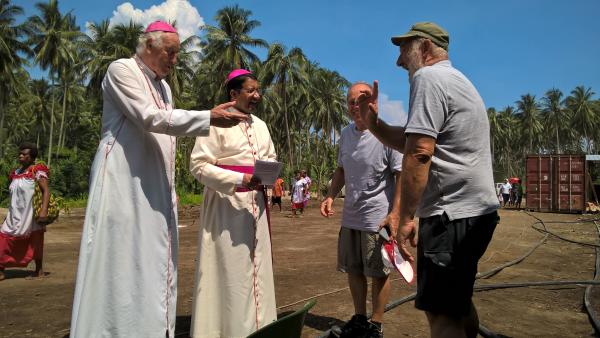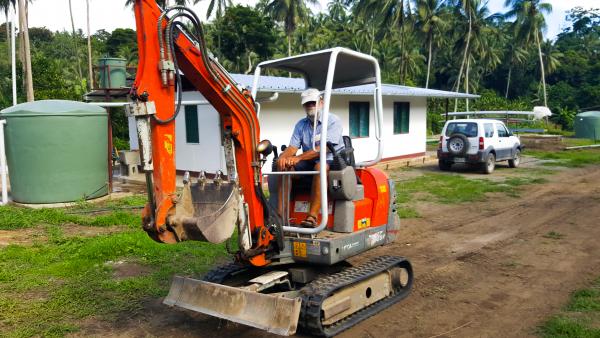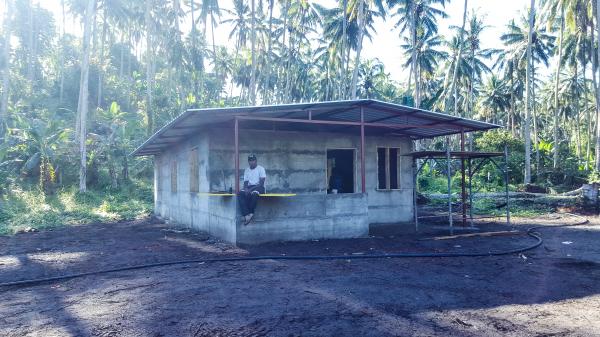14.08.2019 - VSA volunteer Gordon Botha headed off to Papua New Guinea thinking he was going to be an administration adviser to the Catholic Archdiocese of Rabaul. Little did he imagine he’d end up as project manager for two significant building projects: a low-income housing development and a safehouse for victims of family violence.
A primary school principal and teacher for nearly 40 years, Gordon had been told he’d be providing administrative support to the project manager of the archdiocese’s low-income housing build, planned for Kokopo.
“But I got off the plane and everyone said ‘hey hey, our project manager’s arrived!’ So that’s what I was. With a lifetime background in teaching and school administration!”
The Low Income Housing Project is the brainchild of Rabaul’s Archbishop Francesco Panfilo. Gordon says the Archbishop – an Italian – has taken to heart Pope Francis’s pronouncements on alleviating poverty (including, in 2014, “I want a Church which is poor and for the poor”), and decided it’s time for the church in Papua New Guinea to divest itself of some of its sizeable land holdings.

Archbishop Panfilo and the Papal Nuncio at the opening of the first house
With housing for low-income people in PNG’s urban areas often substandard – many live in informal settlements with limited access to clean water and sanitation – Archbishop Panfilo decided to set aside a 19-hectare block of church land to develop into housing for low-income workers.
His plan is ambitious: to build 240 houses over the next 20 years. Each house will be built on an 800sqm plot, and officially the new homeowners will lease the land from the archdiocese but they will own the title to their houses outright.
To help fund the project, Panfilo sold some valuable church land to the provincial government for a promised K4 million (NZ$1.7 million). This was to be paid out in tranches; at the time building began in October 2017, however, just K600,000 (NZ$261,000) had been handed over*. Gordon says a promised large donation from the Catholic bishops’ conference in Italy – on which basis the Archbishop had started the whole project – has never arrived.
So the challenge Gordon faced on his arrival was to build as many homes as possible within the now drastically reduced budget. Incredibly, he and his team managed to build 10 new houses – at a cost of roughly NZ$26,000 each.
Archbishop Panfilo will meet half the cost of each house with the money from the sold church land, leaving K30,000 to be paid by each new homeowner – an amount that would be out of reach for most. So at the suggestion of the archdiocese’s administrator Doug Tennent, they adopted the Habitat for Humanity concept of “sweat equity”.
Under the sweat equity system, homeowners can work off up to half of their debt through labour or some other contribution to the new community – including taking on responsibility for ongoing jobs like rubbish collection. The remaining amount will be deducted over time from their salaries. Gordon designed a recording system for the sweat equity, which the archdiocese reports has continued to work well.
Along with sweat equity, help from generous volunteers has kept building costs down. “Every one or two years a group of the Archbishop’s friends from Milan who have construction skills come and help him on whatever project he’s working on,” says Gordon. In October 2017, 10 of these friends travelled to Kokopo to help with the build – bringing with them a floor plan they’d designed for the houses.
One of Gordon’s first jobs was to find someone to reverse-engineer the Italians’ floorplan into architectural drawings that complied with local planning and building regulations. Gordon says these are reasonably stringent in Papua New Guinea – something which came as a surprise to the visitors. “The Italians couldn’t understand it: they had thought ‘oh we’ll just go there and put up a few houses…’. And in the end, that’s exactly what they did! I had the architectural drawings and handed them on to the Italians, and they just built it from their floor plan anyway!”
After the survey plan they had paid for “turned to custard” and then the surveyor died, Gordon prepared the site himself, marking out the sections on the huge tract of land “with a tape measure and a few star pickets”.
Gordon himself had had little building experience, but as principal of a small rural school in Zimbabwe in the 1990s he had project-managed the construction of homes for some 30 non-professional school staff and their families. In Kokopo, the bulk of the building work was to be done by the Archdiocese’s works department and the Archbishop’s Italian friends. “And my part in it was to manage the project and make sure it happened.”

Gordon at work
Gordon claims he was the least qualified of all the volunteers in Kokopo; but he also thought that he could be “absolutely the right person” for this job.
“If you’d actually gotten a builder/project manager who was top of their game in New Zealand, I don’t think they’d have stayed. It would have been really difficult for them to operate within the codes they’re used to, with all the waiting and the hiccups. Because I wasn’t a dyed-in-the-wool builder, I could actually ride with all of those and find solutions, instead of worrying about what should be.”
The St John 23rd Village (after the late Pope John XXIII) was officially opened by the Papal Nuncio Archbishop Kurian Vayalunkal in November 2017, and over the next few months, the houses were completed.
“The Archdiocese workers were fantastic: they learned quickly from the Italians and they were soon constructing each new building quickly and accurately using the skills they had learnt,” says Gordon.
The new homes are completely off-grid: the power comes from solar panels and water is collected from the roof into tanks. Composting toilets were in the original plan too, but the Italians’ design featured concrete floors which wouldn’t have supported them. Moreover, says Gordon, the toilets weren’t popular with the local people, who saw them as a step backwards to long-drops; they view water-borne sanitation as state-of-the-art.
One of the Archdiocese’s aims with the project was to help their older workers who are coming close to retirement: in a country with no social welfare safety net, the hope is that the new homeowners will be able to cultivate their allotments to sustain themselves and their families once they have no income.
The first homeowner, who was meant to move in in November 2017, seemed to fit this bill. An elderly man working for the Archdiocese, he with his wife and up to 15 family members had been living in just two rooms in makeshift accommodation. Unfortunately, the planned move to the new home did not work out for him.
“We think it was a combination of reasons,” says Gordon. “It was a new situation and one he was not prepared for, or, in the event, happy with. He was familiar and comfortable with what he had, and reluctant to face change. The same could be said for his wife, who was employed at the same place and had a gammy leg.”
The couple found the extra walk to work made living in the new house unviable; there was a bus service but Gordon says the added expense, while not significant, may have been a barrier.
Instead the man moved his son in, “and so he emptied his own house a little I guess. But at the end of this year he’s not going to have a job, so maybe he’ll end up there.”
Gordon says for this man’s family, as for other new villagers, the complexities of managing the different needs of extended family members – schools for the children, travel to distant workplaces – had to be worked through.
The second house went to Dean, a younger Archdiocese worker who was in the construction crew. Married with two children and a third on the way, he and his family had been living in one room of a house they shared with three other families.
In contrast to the first homeowners, Gordon says this family’s move into their new house was “a glorious success”.
“Dean moved straight up there: he started doing things to the place, adapting it for his purpose. And it was wonderful to see. He went from living in a single room with his whole family to living in a three-bedroom house.”
Dean became invaluable to the project as the organiser and supervisor of the sweat equity labour on the site, work for which he received sweat equity “credit” himself. He also took on the crucial job of water measurer.
“Because the whole estate is off the grid – no water connection, they collect the water off the roof – it was very important to know about the precipitation,” says Gordon.
“Although we knew the global average measurements for Kokopo per year, all those things like when it fell and how to store it became very important. So we built our own rain gauge and I asked Dean to be my water measurer. He would keep a weekly table of all the water that fell and all that his family used, so we could monitor this.”
Gordon says he and Dean became great friends, after he had helped Dean’s family move into their new home.
Another member of the new community who made an invaluable contribution was Michael, whose great diplomacy and leadership skills helped defuse many potentially explosive situations.
The land that had been marked out for the new settlement included a copra plantation, abandoned decades earlier by the Archdiocese. (Copra, the dried flesh of the coconut from which coconut oil is extracted, is one of Papua New Guinea’s main cash crops.) In the intervening years, members of the local village had been using the plantation to grow crops, for themselves and to sell at the market.
They were understandably aggrieved at the prospect of losing the gardens, says Gordon: “Here are people who for their whole lifetime have been used to using this as their garden, and now we’ve dispossessed them. So there were political issues to be resolved before we could even go up there.”
However Gordon says it was not so much the cultivators who caused issues in the beginning as “malcontents in the larger community area who had other agendas”.
Enter Michael, who was the ward member for the village, and lived in the traditional Papua New Guinean way. He had shown Gordon around the gardens at the beginning of the project and understood the issues.
With his knowledge of traditional conflict resolution processes, Michael was able to navigate the fraught situation, giving cultivators plenty of notice of the changes planned, keeping them up to date with the situation, and encouraging Gordon’s team to employ village members as labourers on the site, which they did. Michael also encouraged them to employ police guards for a time at the outset “to show the importance of what was being done”.

A complete shell, ready for finishing.
Offering Michael a house in the new village turned out to be the best thing they could have done, says Gordon: “He was a guy who lived in a village, and he knew about community, and how to build viable communities. As soon as we moved him in there, he was the guy who showed the way with the cultivation and the gardens – and not just the vegetables but he grew marvellous flowers and made the place look really beautiful.”
Michael has covered his land with maize, kaukau (kumara), taro, Singapore (a root crop), taro and bananas. More importantly, though, he has helped build a sense of community in Saint John 23rd Village. He has become the de facto village leader, says Gordon: what Papua New Guineans call the “waspapa”.
“He taught everybody else who moved in how to behave, and how to work with each other and how to build a community.
“We kind of got lucky: we didn’t actually appoint him to that position – but we could see that it was needed, and the fact that he did it and became the nucleus around which the whole community spirit of the new village that began to develop… I just watched what he was doing and said to him ‘this is just fantastic. What you’re doing is making a difference’.”
There have been some teething problems, says Gordon, but Michael always helped smooth the way.
“There’ve been little things like stuff went missing, and questions around ‘how do we resolve these sorts of issues?’ And in all of these things, Michael had his ways and means, and he knew how they did it in the village. The talk sessions and the working together with different people up there to get them all on the same page, that was definitely happening.”
Capacity-building was another important aspect of Gordon’s work as a VSA volunteer. He designed a series of seminars to upskill the new homeowners around how to live comfortably and efficiently in the new eco-homes.
For four Saturdays in a row, all the new villagers and their dependents would meet at a different house and tackle a new subject. Gordon organised presentations with guest experts on topics including managing their water supply and how to use the solar power efficiently and maintain the battery.
“Everybody pitched up for the demonstration and a talk, and the excitement and the buy-in from all the people who came to those was absolutely wonderful.”
The final session was a community breakfast, featuring foods that could be grown in the villagers’ allotments. Gordon invited Johannes Gambo, VSA’s programme manager in Papua New Guinea, to offer his expertise on gardening and healthy, low-cost eating, and Kokopo’s other VSA volunteers all joined in on the session – “which helped to build our own community spirit!” He adds that a small grant from VSA to the project was gratefully received: "it allowed it to be beautiful instead of merely functional."
Michael and the archdiocese administrator have worked together on several further initiatives to develop community spirit and pride.
The last house was completed in July, and Gordon says the village is now buzzing.
“I went up to visit on the night of my farewell party, and to see the solar security lights on and everybody sitting under their solar lights and all the kids out running around, it was really great.”
Read about East New Britain's first safe house, which Gordon was also involved in, here.
